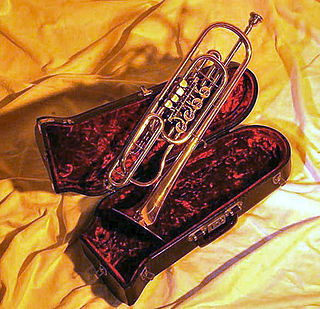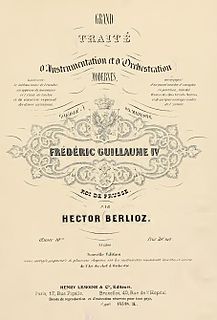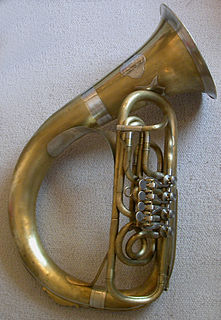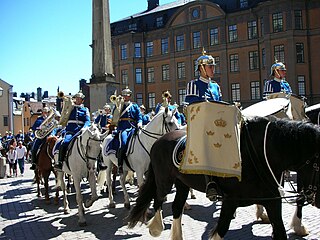Related Research Articles

The euphonium is a medium-sized, 3 or 4-valve, often compensating, conical-bore, tenor-voiced brass instrument that derives its name from the Ancient Greek word εὔφωνος euphōnos, meaning "well-sounding" or "sweet-voiced". The euphonium is a valved instrument. Nearly all current models have piston valves, though some models with rotary valves do exist.

The tuba is the lowest-pitched musical instrument in the brass family. As with all brass instruments, the sound is produced by lip vibration – a buzz – into a mouthpiece. It first appeared in the mid-19th century, making it one of the newer instruments in the modern orchestra and concert band. The tuba largely replaced the ophicleide. Tuba is Latin for "trumpet".

The bass trumpet is a type of low trumpet which was first developed during the 1820s in Germany. It is usually pitched in 8' C or 9' B♭ today, but is sometimes built in E♭ and is treated as a transposing instrument sounding either an octave, a sixth or a ninth lower than written, depending on the pitch of the instrument. Having valves and the same tubing length, the bass trumpet is quite similar to the valve trombone, although the bass trumpet has a harder, more metallic tone. Certain modern manufacturers offering 'valve trombones' and 'bass trumpets' use the same tubing, valves, and bell, in different configurations - in these cases the bass trumpet is virtually identical to the valve trombone.

The Wagner tuba is a four-valve brass instrument named for and commissioned by Richard Wagner. It combines technical features of both standard tubas and French horns, though despite its name, the Wagner tuba is more similar to the latter, and usually played by horn players. Wagner commissioned the instrument for his four-part opera cycle Der Ring des Nibelungen, where its purpose was to bridge the acoustical and textural gap between the French horn and trombone.
The year 1835 in science and technology involved some significant events, listed below.

A fife is a small, high-pitched, transverse aerophone of Portuguese origin, that is similar to the piccolo. The fife originated in medieval Europe and is often used in Fife and Drum Corps, military units, and marching bands. Someone who plays the fife is called a fifer. The word fife comes from the German Pfeife, meaning pipe, which comes from the Latin word pipare.
The contrabass clarinet and contra-alto clarinet are the two largest members of the clarinet family that are in common usage. Modern contrabass clarinets are pitched in B♭, sounding two octaves lower than the common B♭ soprano clarinet and one octave lower than the B♭ bass clarinet. Some contrabass clarinet models have a range extending down to low (written) E♭, while others can play down to low D or further to low C. This range, C(3) – E(6), sounds B♭(0) – D(4), see the table on the right. Some early instruments were pitched in C; Arnold Schoenberg's Fünf Orchesterstücke specifies a contrabass clarinet in A, but there is no evidence of such an instrument ever having existed.

Wilhelm Friedrich Wieprecht was a German musical conductor, composer and inventor.
The contrabass trombone is the lowest instrument in the trombone family of brass instruments. A true contrabass trombone is pitched an octave below the B♭ tenor trombone. However, since the late 20th century, it has largely been supplanted by a bass-contrabass instrument pitched in F, a perfect fourth below the tenor trombone. Wagner first specified the contrabass for his Der Ring des Nibelungen opera cycle in the 1870s, and it has since appeared occasionally in large orchestral works without becoming a permanent member of the modern orchestra. In the 21st century it has enjoyed something of a revival, particularly in film and video game soundtracks.

Grand traité d’instrumentation et d’orchestration modernes, abbreviated in English as the Treatise on Instrumentation is a technical study of Western musical instruments written by Hector Berlioz. It was first published in 1844 after being serialised in many parts prior to this date and had a chapter added by Berlioz on conducting in 1855.

The helicon is a brass musical instrument in the tuba family. Most are B♭ basses, but they also commonly exist in E♭, F, and tenor sizes, as well as other types to a lesser extent.

The saxotromba is a valved brass instrument invented by the Belgian instrument-maker Adolphe Sax around 1844. It was designed for the mounted bands of the French military, probably as a substitute for the French horn. The saxotrombas comprised a family of half-tube instruments of different pitches. By about 1867 the saxotromba was no longer being used by the French military, but specimens of various sizes continued to be manufactured until the early decades of the twentieth century, during which time the instrument made sporadic appearances in the opera house, both in the pit and on stage. The instrument is often confused with the closely related saxhorn.

The saxtuba is an obsolete valved brasswind instrument conceived by the Belgian instrument-maker Adolphe Sax around 1845. The design of the instrument was inspired by the ancient Roman cornu and tuba. The saxtubas, which comprised a family of half-tube and whole-tube instruments of varying pitches, were first employed in Fromental Halévy's opera Le Juif errant in 1852. Their only other public appearance of note was at a military ceremony on the Champ de Mars in Paris in the same year. The term "saxtuba" may also refer to the bass saxhorn.

The Royal Swedish Cavalry Band is one of three professional military bands in the Swedish Armed Forces. The band traces its ancestry back to the 1500s when King Gustav Vasa raised his first regiment of horse. Today LDK is one of few mounted bands in the world. The band rides at the head of the Life Guards through Stockholm when mounting the King's Guard and the parade is considered one of Sweden's main tourist attractions. This band reports as part of the Swedish Armed Forces Music Corps, which is responsible for the formation and maintenance of Swedish military bands
The York Band Instrument Company was a musical instrument manufacturer in Grand Rapids, Michigan.

Music technology is the study or the use of any device, mechanism, machine or tool by a musician or composer to make or perform music; to compose, notate, play back or record songs or pieces; or to analyze or edit music.

Mechanical music technology is the use of any device, mechanism, machine or tool by a musician or composer to make or perform music; to compose, notate, play back or record songs or pieces; or to analyze or edit music. The earliest known applications of technology to music was prehistoric peoples' use of a tool to hand-drill holes in bones to make simple flutes. Ancient Egyptians developed stringed instruments, such as harps, lyres and lutes, which required making thin strings and some type of peg system for adjusting the pitch of the strings. Ancient Egyptians also used wind instruments such as double clarinets and percussion instruments such as cymbals. In Ancient Greece, instruments included the double-reed aulos and the lyre. Numerous instruments are referred to in the Bible, including the horn, pipe, lyre, harp, and bagpipe. During Biblical times, the cornet, flute, horn, organ, pipe, and trumpet were also used. During the Middle Ages, hand-written music notation was developed to write down the notes of religious Plainchant melodies; this notation enabled the Catholic church to disseminate the same chant melodies across its entire empire.

Johann Gottfried Moritz was a German musical instrument builder, best known as one of the inventors of the modern tuba.
Carl August Buchholz was a German organ builder.

Karl Ludwig Alexander Schuke was a German organ builder. The son of the organ builder Alexander Schuke, he continued, together with his brother Hans-Joachim Schuke, to run their father's company in Potsdam until 1953, when he founded another organ building company, the Karl Schuke Berliner Orgelbauwerkstatt in West Berlin. They have built organs internationally in Korea, Australia and the U.S.
References
- ↑ Der Berliner Blasinstrumentenbau im 19. Jahrhundert - Gesine Haase, 1981
- ↑ [Alfred Berner: Moritz, Blasinstrumentenmacher. In: Neue Deutsche Biographie (NDB). Band 18, Duncker & Humblot, Berlin 1997, ISBN 3-428-00199-0, S. 146]